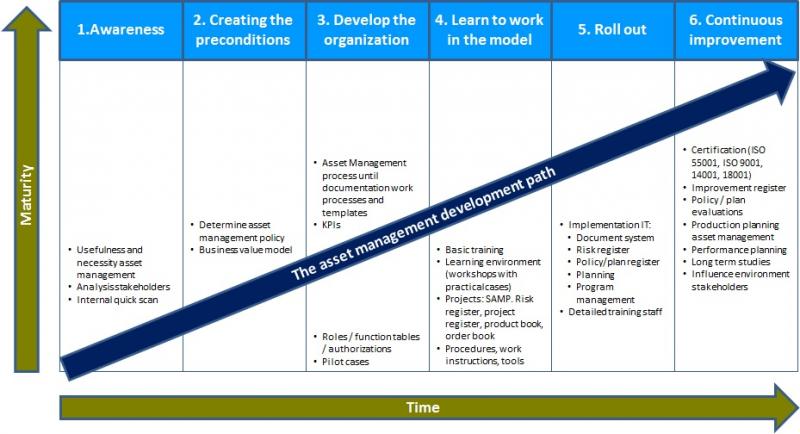Develop with ISO55001
21 February 2014 • John de Croon
asset management strategie
In the coming months, there is solid reason for the International Organization for Standardization to have party, because the long-awaited ISO55000 series has finally come true. The committee obviously now knows what an asset is. It will not take long before announcements come from organizations that they want to have their ISO55001 certificate on the wall somewhere mid-2015. Some time ago, in May 2012 to be precise, we have argued that it is not smart to go for a 'cold' PAS55 certification[1]. The arguments we then presented are also valid for ISO55001. The question remains then how the process to be taken should look like. We present it here.
The argument was that an optimized added value is not created for the stakeholders of the capital-intensive organization, if just a cold PAS55 (and soon ISO55001) certification is achieved. So with only a certification an organization is not yet a proper asset manager. Asset management is a process of continuous improvement, where quick and dirty solutions do not work. To improve, a good foundation is required and this foundation is not achieved with just the certificate. A process of several years is necessary in order to arrive to continuous improvement.
Thus, effort should be made in the area of the support, capturing and implementing new processes, train employees and to implement enabling technology. And then we assume the organization structure with appropriate responsibilities and authorities does not need to be adjusted, with which political and power play games come into place. Remember that the current best practice asset managers sometimes have needed more than five years to arrive at the level where they are now. In short, to become a proper asset manager a change process is required. With the growing experience this can be done faster than before, but it remains time consuming. In any change process, a number of steps can be distinguished, which are more or less intense dependent on the size. Our growth model fits nicely with this change process.
In the first phase should be clear what the problem is and why the change is needed. This is called the awareness phase, in which the usefulness and necessity of change needs to be made clear.
Then goals and organizational frameworks need to be defined. In the next step, the preconditions are created. With the asset management policy and business value model (business values and the risk matrix) of this phase an initial risk analysis is performed and quickly first successes (savings if you like) can be achieved.
Then the organization is developed with a formalization of products of the process. These are basic elements such as processes with its outputs, tasks / responsibilities and authorizations. Also, a number of pilots with a limited number of employees are conducted in which the determined basic elements are applied. A second series of successes can be achieved and the implementation will become easier, because the new system has been tested already.
Now you can learn to work in the model. In this phase, you will see a shift from products from the process to products in the process (risk register, issues list, policy data base). Employees receive a basic asset management training and the scope is expanded from the pilots to all assets.
In the large-scale roll out of asset management the (IT) systems are such implemented so that the method is supported as much as possible. The products associated with the process are ‘stuck’ in here, because during a large-scale rollout of course you should not change the rules halfway through.
With this roll out, the asset management system becomes mature and a cycle of continuous improvementis started. The change is irreversible. In this phase there will be a renewed interest in the improvement of the process. When an asset manager runs through these steps, certification is a logical next step. The overall schedule looks like this.

Precisely that continuous improvement is essential. Organizations that only aspire a cold certification, will be awoken a rather rude way in the next audit round. If your ambition is just a certificate, it is extremely difficult to demonstrate continuous improvement. This is a tough requirement to be able maintain the ISO55001 certificate (as well as for PAS55). So it is a matter of a longer breath. But do not worry, where the best practice asset managers had to virtually invent and develop everything themselves, luckily now reference models are available. It's your choice how to develop and what kind of party it will be.
John de Croon is partner at AssetResolutions BV, a company he co-founded with Ype Wijnia. In turn, they give their vision on an aspect of asset management in a weekly column. The columns are published on the website of AssetResolutions, http://www.assetresolutions.nl/en/column
<< back to overview
|


